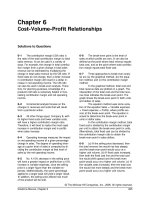Cost management HM cost 3e CLE ch06
Bạn đang xem bản rút gọn của tài liệu. Xem và tải ngay bản đầy đủ của tài liệu tại đây (32.16 KB, 2 trang )
CHAPTER 6
Process Costing
COLLABORATIVE LEARNING EXERCISE
OBJECTIVE 3
Consider the following conversation between Keri Swasey, manager of a division that
produces riding lawn mowers, and her controller, Stoney Lawson, a CMA and CPA:
KERI: Stoney, we have a real problem. Our operating cash is too low, and we are in
desperate need of a loan. As you know, our financial position is marginal, and we need to
show as much income as possible—and our assets need bolstering as well.
STONEY: I understand the problem, but I don’t see what can be done at this point. This
is the last week of the fiscal year, and it looks as if we’ll report income just slightly above
break even.
KERI: I know all this. What we need is some creative accounting. I have an idea that
might help us, and I wanted to see if you would go along with it. We have 600 partially
finished mowers in process, about 20 percent complete. That compares with the 3,000
units that we completed and sold during the year. When you computed the per-unit cost,
you used 3,120 equivalent units, giving us a manufacturing cost of $1,500 per unit. That
per-unit cost gives us cost of goods sold equal to $4.5 million and ending work in process
worth $180,000. The presence of the work in process gives us a chance to improve our
financial position. If we report the units in work in process as 80 percent complete, this
will increase our equivalent units to 3,480. This, in turn, will decrease our unit cost to
about $1,345 and cost of goods sold to $4.035 million. The value of our work in process
will increase to $645,600. With those financial stats, the loan would be a cinch.
STONEY: Keri, I don’t know. What you’re suggesting is risky. It wouldn’t take much
auditing skill to catch this one.
KERI: You don’t have to worry about that. The auditors won’t be here for at least six to
eight more weeks. By that time, we can have those partially completed units completed
and sold. I can bury the labor cost by having some of our more loyal workers work
overtime for some bonuses. The overtime will never be reported. And, as you know,
bonuses come out of the corporate budget and are assigned to overhead—next year’s
overhead. Stoney, this will work. If we look good and get the loan to boot, corporate
headquarters will treat us well. If we don’t do this, we could lose our jobs.
Required:
Form groups of three to five students, where the total number of groups is divisible by
four. The numbers 1, 2, 3, or 4 will be assigned to each group. Groups with number 1 will
© 2015 Cengage Learning. All Rights Reserved. May not be scanned, copied or duplicated, or posted to a publicly
accessible website, in whole or in part.
solve Requirement 1, groups with number 2 will solve Requirement 2, etc. Each group
will share their answers with the other groups.
1. Should Stoney agree to Keri’s proposal? Why or why not? To assist in deciding,
review the standards of ethical conduct for management accountants described in
Chapter 1. Do any apply?
2. Assume that Stoney refuses to cooperate and that Keri accepts this decision and
drops the matter. Does Stoney have any obligation to report the divisional
manager’s behavior to a superior? Explain.
3. Assume that Stoney refuses to cooperate. However, Keri insists that the changes
be made. Now what should Stoney do? What would you do?
4. Suppose that Stoney is 63 years old and that his prospects for employment
elsewhere are bleak. Assume again that Keri insists that the changes should be
made. Stoney also knows that Keri’s superior, the owner of the company, is her
father-in-law. Under these circumstances, would your recommendations for
Stoney differ? If you were Stoney, what would you do?
© 2015 Cengage Learning. All Rights Reserved. May not be scanned, copied or duplicated, or posted to a publicly
accessible website, in whole or in part.









